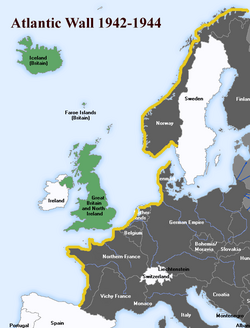
Back الجدار الأطلسي Arabic Atlantik səddi Azerbaijani Атлантически вал Bulgarian Moger ar Meurvor Atlantel Breton Mur Atlàntic Catalan Atlantický val Czech Atlantvolden Danish Atlantikwall German Dêso Atlantik DIQ Τείχος του Ατλαντικού Greek
| Atlantic Wall | |
|---|---|
| Part of Nazi Germany | |
| Western coast of Continental Europe and Scandinavia | |
 | |
| Type | Coastal defence and fortifications |
| Length | 1670 miles (2687 km) |
| Site information | |
| Controlled by | |
| Condition | Partially demolished; mostly intact |
| Site history | |
| Built | 1942–1944 |
| Built by | Forced labourers |
| In use | 1942–1945 |
| Materials |
|
| Battles/wars | World War II |
| Events | St Nazaire Raid Dieppe Raid Operation Overlord Operation Undergo Battle of the Scheldt |
| Garrison information | |
| Past commanders | Erwin Rommel (1943–1944) |
| Occupants | Wehrmacht |
The Atlantic Wall (German: Atlantikwall) was an extensive system of coastal defences and fortifications built by Nazi Germany between 1942 and 1944 along the coast of continental Europe and Scandinavia as a defence against an anticipated Allied invasion of Nazi-occupied Europe from the United Kingdom, during World War II. The manning and operation of the Atlantic Wall was administratively overseen by the German Army, with some support from Luftwaffe ground forces. The Kriegsmarine (German Navy) maintained a separate coastal defence network, organised into a number of sea defence zones.[1]
Hitler ordered the construction of the fortifications in 1942 through his Führer Directive No. 40. More than half a million French workers were drafted to build it. The wall was frequently mentioned in Nazi propaganda, where its size and strength were usually exaggerated. The fortifications included colossal coastal guns, batteries, mortars, and artillery, and thousands of artillery pieces were stationed in its defences.[a] Today, ruins of the wall exist in all of the nations where it was built, although many structures have fallen into the ocean or have been demolished over the years.
- ^ Lohmann, Walter; H. Hildebrand, Hans (1956). Imagem da capa de Die deutsche Kriegsmarine, 1939-1945 : Gliederung, Einsatz, Stellenbesetzung Die deutsche Kriegsmarine, 1939-1945 : Gliederung, Einsatz, Stellenbesetzung. H.H Podzun, Bad Nauheim. OCLC 61588484.
- ^ Kaufmann, J. E.; Kaufmann, H. W.; Jankovic-Potocnik, A.; Tonic, Vladimir (2012). The Atlantic Wall: History and Guide. Pen and Sword. ISBN 978-1-78337-838-8.
Cite error: There are <ref group=lower-alpha> tags or {{efn}} templates on this page, but the references will not show without a {{reflist|group=lower-alpha}} template or {{notelist}} template (see the help page).